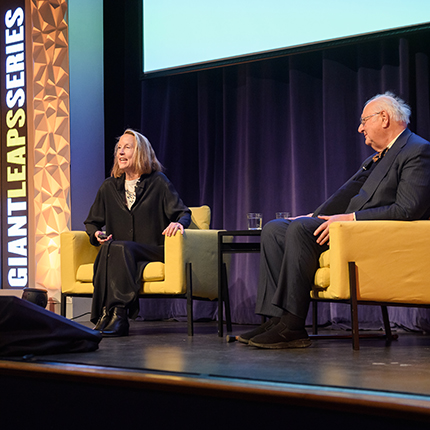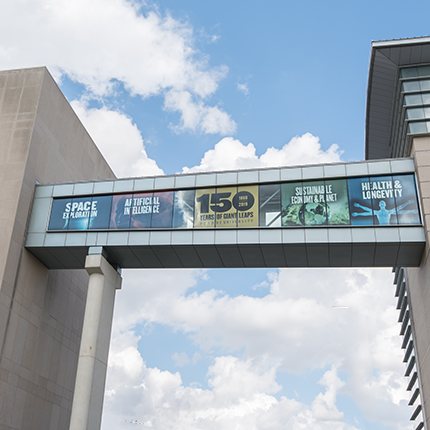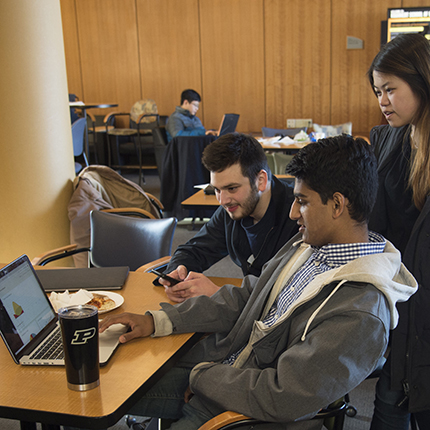Seeing It Through
Program gives entrepreneurs practical advice, direction to launch startups
Shruthi Suresh and Ting Zhang, two Purdue doctoral students, thought they had a great idea to help blind and visually impaired people. The NSF I-Corps program helped them come up with an even better idea to launch a startup moving their innovation into the public.
“The I-Corps program allowed us to get out of our comfort zone and understand our invention from a customer perspective,” says Suresh, a PhD student in the Weldon School of Biomedical Engineering. “It’s a rare insight that very few students get to see as inventors or as researchers.”
Suresh co-founded HaptImage with Zhang, a doctoral student in the Purdue School of Industrial Engineering. Their startup enables individuals with visual impairments to study science, technology, engineering or mathematics (STEM) and pursue related careers through its real time image-accessing tool.
“I learned that customers’ needs are an important factor to consider for any product,” Zhang says. “The Purdue I-Corps program provided us the opportunity to understand the customer needs all over the country. It also extended our discussion on defining our own value proposition, production channels and key roles involved in the commercialization ecosystem.”
“I-Corps is about helping researchers figure out the commercial potential of their research and the path to commercialization before they invest heavily in more applied work, such as prototyping or starting a company,” says Lynall, a clinical professor of management. “NSF has been instructed by Congress to scale up I-Corps significantly, so it is piloting new programs to reduce participation obstacles and adding new university sites and nodes to increase training capacity.”
Acting as an I-Corps Node, Purdue conducted the seven-week National Innovation Teams Program in Indianapolis in fall 2018. During the workshop, I-Corps teams completed over 100 customer discovery interviews, which are face-to-face conversations with potential customers or stakeholders that end with a ‘go or no-go’ decision on commercializing their technology.
“The I-Corps program is rigorous,” Lynall says. “This is important because the teams’ experiences inform their next step, which is typically to apply for early stage funding to help them survive the initial negative revenue phase between research development and positive income known as the ‘valley of death.’ Participation in I-Corps dramatically increase a team’s success in this process.”
Zhang and Suresh, who developed their haptic feedback, imaging accessing system in the Duerstock Institute for Accessible Science Lab and in the Intelligent Systems and Assistive Technologies Lab, completed the national I-Corps workshop in 2018 prior to creating HaptImage.
The experience helped Zhang and Suresh reorient their initially generalized user, school-based system to a single-user, individually owned system. HaptImage’s image-accessing technology, which is licensed through the Purdue Office of Technology Commercialization, was presented in April at the 2019 University Innovation and Entrepreneurship Showcase in Washington, D.C.
The event is held annually by the Association of American Universities and the Association of Public and Land-grant Universities to highlight federally funded university research that advances entrepreneurship, innovation and economic opportunities. Startups were selected on criteria including the use of federal research funds to create and commercialize technologies to improve lives and contribute to the global society.
The HaptImage technology employs an algorithm that changes digital images into physical sensations that impersonate the would-be exterior of a portrayed object. Users hold a joystick that resembles an ink pen that makes vibrations and resistance in correspondence with the digital object’s shape and feel while users move the joystick around.
What this means is that students can interact in a classroom setting in real time. Previously, such students needed an on-screen 3D-printed mockup or an audio description to aid their learning.
“The technology helps students interact in real time while in a classroom and creates ‘touch-based learning.’ That is critical for all students, but especially for students who are blind or have limited vision,” Suresh says. “Real-time access to images is crucial to allow social integration and education for individuals who are blind or with limited vision. It also will help individuals with visual impairments pursue image-dependent careers like architecture and access social media platforms.”







